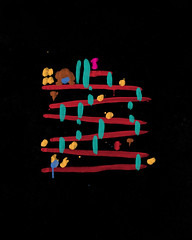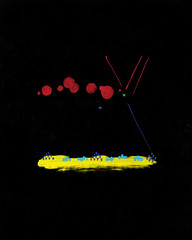Fair Use of Videogame Screens
I came across this article which pointed me to three recent paintings by Brock Davis (a/k/a Laser Bread), all of which are the painter's takes on some classic videogames.
I'll put the game names at the bottom, because it should take about half a second for gamers of a certain age to recognize these.



And for those of you think of gaming systems [obSnydeQuipMaskingJealousy], that's Dig Dug, Donkey Kong, and Missile Command.
The geek in me abso-lurves these, for aesthetic and nostalgic value. The lawyer in me went directly to the fair use analysis.
There's no question that the iconic videogame screens that these paintings are based on are subject to copyright. Actually, there is some question, as it can be argued that the Missile Command and Dig Dug screens were jointly created by the end user, but that's a question for another post. Let's just take that point as read.
The fair use analysis is actually fairly straightforward. You've got a transformative use that will have no impact on the market for the games, or even (taking a more controversial reading of the fourth factor) the potential derivative market for the games. That's factors one and four in favor of fair use. Factor four used to be the "first among equals," more recently the question of "transformative use" is filling that role, but in this case both cut in favor of finding fair use.
Admittedly, the game screen is a creative work, which puts factor 2 in the not-fair-use column. and it could be argued that the amount taken is substantial - it would depend on the determination of what, exactly, constituted the work; is it the game overall or individual screens. But these are relatively weak and would bow in any event to the determination mandated by factors 1 and 4.
Another question would be the trademark implications. These images are, I would posit, fairly iconographic, and each of the screenshots then very likely identify a source (Namco, Nintendo, Atari respectively) The proof is in the pudding, in that (as noted) gamers of a certain age probably recognized the game identities from the paintings without any difficulty.
I don't have a link, but I recall seeing sites where you can submit a digital image and get a painting. Presumably to different levels of abstractness. In which case Atari might be able to argue that a consumer seeing the paintings might be confused as to the source or - in this case the stronger argument - sponsorship of the paintings.
Fair use analysis in trademarks tends to concentrate on the whole "nominative use" question, but that won't do any work for us here. Trademark fair use as a doctrine is mainly concerned with trademarks that are also words in the language and limitations on the extent to which trademark rights can curtail the use of language. Which, sadly, also doesn't do much work for us here.
So on a purely doctrinal level, it seems that the game makers could make at least an objectively reasonable (not Rule 11 sanctionable) trademark infringement case against the artist, claiming that consumers might mistakenly believe that the game maker had sponsored the painting. And his defense would have to be "no they won't," which is a poor defense in that it doesn't do any work pre-trial, or at least pre-survey -- which is to say pre-expensive.
The saving grace for Mr. Davis might be the practical factors militating against the manufacturer's bringing suit, to wit, the negative publicity, the paucity of available damages, the relative age (value) of the marks allegedly infringed, etc.
I think that's the right answer on the law, but it disappoints me on the facts. There should be space in the law for exactly this kind of expression. I touch on this briefly in my post about the Carol Burnett - Family Guy dustup here. And this is another example of where the conversation of our world is being impeded by the very laws that were intended to protect that conversation (albeit a different facet of that conversation.)
--B

